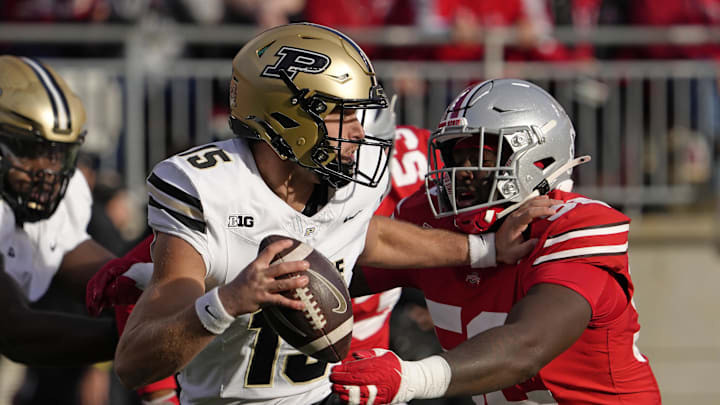Every week, it seems like a new depth player makes a play for the Ohio State football team and gives fans even more excitement for the future. This week, Jeremy Birmingham and Austin Ward of THE Podcast pointed out how one player showed up and put himself and a new position on display which will be helpful now and in the future as Ohio State tries to add one or two more players to the class.
Joshua Mickens' performance against Purdue was a standout moment for Ohio State’s defense, signaling a potential shift in strategy that could lead to more playing time for him and others. With Mickens stepping into the "Jack" position—a hybrid role allowing a player to act as both an edge rusher and a linebacker—Ohio State's defense is becoming more dynamic and versatile. This approach enables them to better utilize their athletic depth, giving players like Mickens a chance to shine.
Mickens, a player who had largely flown under the radar despite being a top 150 recruit and the best player in Indiana, according to 247 Sports, made an immediate impact. He recorded a sack in his first series against Purdue and quickly disrupted more plays, showcasing his speed and physicality.
His ability to thrive in the Jack role highlights Ohio State’s growing willingness to break away from their traditional 4-3 defensive scheme. This evolution is something fans once saw from defensive coordinator Jim Knowles when he was at Oklahoma State, but fans have not seen much of it since he got to Ohio State.
The Ohio State football team changing their defense opens things up for recruits
The introduction of the Jack position is part of Ohio State's broader defensive adjustments. After a disappointing game against Oregon earlier in the season, where Alabama head coach Nick Saban referred to Ohio State's pass rush as "antiquated," there has been a clear effort to be more creative with their defensive alignments. Ohio State has experimented with three-man fronts and hybrid players like Mickens, C.J. Hicks, and Mitchell Melton to add more flexibility to their defense.
This shift in strategy could also have major recruiting implications. Birmingham pointed out on the Thursday morning episode of THE Podcast Daily that one notable example is 2025 recruit Justin Hill, an Ohio linebacker currently committed to Alabama.
Hill initially chose Alabama over Ohio State because he felt Ohio State had not fully embraced positions like the Jack, which allow athletes to play multiple roles. However, as Ohio State now shows a willingness to adopt these schemes, they may make a late push to convince Hill and other recruits that the Buckeyes can be a better fit for versatile players like him.
Ohio State’s recent changes mirror what they have done with hybrid players in the past. Last season, they used Sonny Styles as a safety-linebacker hybrid, and this year, Jordan Hancock has been used as a cornerback-safety hybrid. These moves not only modernize Ohio State’s defense but also show a commitment to maximizing their athletes' versatility.
The emergence of players like Mickens and Ohio State’s adoption of more innovative defensive schemes are promising signs. While these adjustments may not become staples of this season, the flexibility and creativity they’ve shown suggest that Ohio State’s defense is poised for success in both the immediate future and on the recruiting trail.
This new defensive approach could give Ohio State an edge both on the field and in securing top talent for years to come.
